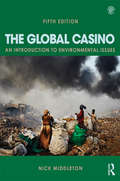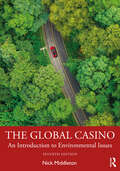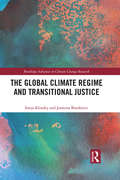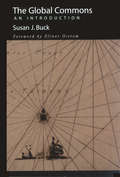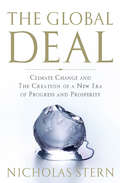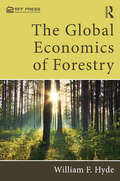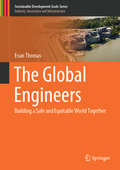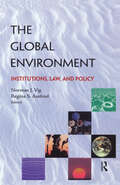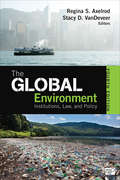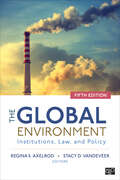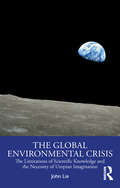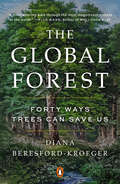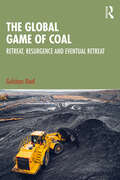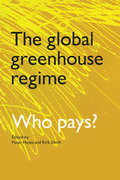- Table View
- List View
The Glitter in the Green: In Search of Hummingbirds
by Jon DunnAn acclaimed natural history writer follows the trail of the remarkable hummingbird all over the world. Hummingbirds are a glittering, sparkling collective of over three hundred wildly variable species. For centuries, they have been revered by indigenous Americans, coveted by European collectors, and admired worldwide for their unsurpassed metallic plumage and immense character. Yet they exist on a knife-edge, fighting for survival in boreal woodlands, dripping cloud forests, and subpolar islands. They are, perhaps, the ultimate embodiment of evolution's power to carve a niche for a delicate creature in even the harshest of places. Traveling the full length of the hummingbirds' range, from the cusp of the Arctic Circle to near-Antarctic islands, acclaimed nature writer Jon Dunn encounters birders, scientists, and storytellers in his quest to find these beguiling creatures, immersing us in the world of one of Earth's most charismatic bird families.
The Global Casino, Fifth Edition: An Introduction to Environmental Issues
by Nick MiddletonThe Global Casino is an introduction to environmental issues which deals both with the workings of the physical environment and the political, economic and social frameworks in which the issues occur. Using examples from all over the world, the book highlights the underlying causes behind environmental problems, the human actions which have made them issues, and the hopes for solutions. It is a book about the human impact on the environment and the ways in which the natural environment impacts human society. The fifth edition has been fully revised and updated throughout, with new case studies, figures, and online resources such as downloadable figures and tables from the text and multiple choice questions for students, accessible at: www.routledge.com/cw/middleton. New topics covered in extended boxed case studies include payment for environmental services, ocean acidification, biofuels in Brazil, waste reduction through industrial symbiosis, and the long-term impact of natural disasters on vulnerable groups. Other approaches and concepts covered for the first time in this new edition include traditional ecological knowledge, environmental justice, the ‘resource curse’, and urban biodiversity. Eighteen chapters on key issues follow three initial chapters which outline the background contexts of the physical and human environments and the concept of sustainable development. Each chapter provides historical context for key issues, outlines why they have arisen, and highlights areas of controversy and uncertainty to appraise how issues can be resolved both technically and in political and economic frameworks. Each chapter also contains an updated critical guide to further reading and websites, as well as discussion points and essay questions. The text can be read in its entirety or individual chapters adopted as standalone reading. The Global Casino is an essential resource for students of the environment, geography, earth sciences and development studies. It provides comprehensive and inspirational coverage of all the major global environmental issues of the day in a style that is clear and critical.
The Global Casino: An Introduction to Environmental Issues
by Nick MiddletonThe Global Casino is an introduction to environmental issues which deals both with the workings of the physical environment and with the political, economic and social frameworks in which the issues occur. Using examples from all over the world, the book highlights the underlying causes behind environmental problems, the human actions which have made them issues, and the hopes for solutions. It is a book about the human impact on the environment and the ways in which the natural environment impacts human society. The sixth edition has been fully revised and updated throughout, with new case studies, figures, and online resources including a complete lecture course for tutors and multiple-choice questions for students. New concepts and topics covered for the first time in this edition include the green economy, the forest transition model, marine microplastic pollution, urban disasters, decommissioning of big dams, and the start of the Anthropocene. Recent international initiatives covered include the Paris Agreement on climate change, the Aichi Biodiversity Targets, and the Sendai Framework for managing disaster risk. New case studies include Morocco’s Noor concentrated solar power plant, desert recovery in Kuwait, and river management on the Huang Ho. Eighteen chapters on key issues follow three initial chapters which outline the background contexts of the physical and human environments and the concept of sustainable development. Each chapter provides historical context for key issues, outlines why they have arisen, and highlights areas of controversy and uncertainty to appraise how issues can be resolved both technically and in political and economic frameworks. Each chapter also contains an updated critical guide to further reading – many of them open access – and websites, as well as discussion points and essay questions. The text can be read in its entirety or individual chapters adopted as standalone reading. This book is an essential resource for students of the environment, geography, earth sciences and development studies. It provides comprehensive and inspirational coverage of all the major global environmental issues of the day in a style that is clear and critical.
The Global Casino: An Introduction to Environmental Issues
by Nick MiddletonThe Global Casino is an introduction to environmental issues which deals both with the workings of the physical environment and the political, economic and social frameworks in which the issues occur. Using examples from all over the world, the book highlights the underlying causes behind environmental problems, the human actions which have made them issues and the hopes for solutions. It is a book about the human impact on the environment and the ways in which the natural environment impacts human society.The seventh edition has been fully revised and updated throughout, with new case studies, figures and online resources comprising a complete lecture course for tutors and multiple-choice questions for students. New concepts and topics covered for the first time in this edition include the blue economy, marine heatwaves, Africa’s Great Green Wall, rewilding, net-zero commitments, nature-based solutions, emerging contaminants in global rivers, green infrastructure in sustainable cities, initiatives promoting zero-emission vehicles, and zoonotic diseases (including the COVID-19 pandemic). New case studies include gender impact assessment of big dams in Laos and Vietnam, reducing food loss and waste, liming sugar maple trees in North America to counteract soil acidification and soil erosion and poverty in Rwanda. Eighteen chapters on key issues follow three initial chapters which outline the background contexts of the physical and human environments and the concept of sustainable development. Each chapter provides historical context for key issues, outlines why they have arisen and highlights areas of controversy and uncertainty to appraise how issues can be resolved both technically and in political and economic frameworks. Each chapter also contains an updated critical guide to further reading—most of them open access—and websites, talks and podcasts, as well as discussion points and essay questions. The text can be read in its entirety or individual chapters adopted as standalone reading.This book is an essential resource for students of the environment, geography, development studies and earth sciences. It provides comprehensive and inspirational coverage of all the major global environmental issues of the day in a style that is clear, concise and critical.
The Global Climate Regime and Transitional Justice (Routledge Advances in Climate Change Research)
by Jasmina Brankovic Sonja KlinskyGeopolitical changes combined with the increasing urgency of ambitious climate action have re-opened debates about justice and international climate policy. Mechanisms and insights from transitional justice have been used in over thirty countries across a range of conflicts at the interface of historical responsibility and imperatives for collective futures. However, lessons from transitional justice theory and practice have not been systematically explored in the climate context. The comparison gives rise to new ideas and strategies that help address climate change dilemmas. This book examines the potential of transitional justice insights to inform global climate governance. It lays out core structural similarities between current global climate governance tensions and transitional justice contexts. It explores how transitional justice approaches and mechanisms could be productively applied in the climate change context. These include responsibility mechanisms such as amnesties, legal accountability measures, and truth commissions, as well as reparations and institutional reform. The book then steps beyond reformist transitional justice practice to consider more transformative approaches, and uses this to explore a wider set of possibilities for the climate context. Each chapter presents one or more concrete proposals arrived at by using ideas from transitional justice and applying them to the justice tensions central to the global climate context. By combining these two fields the book provides a new framework through which to understand the challenges of addressing harms and strengthening collective climate action. This book will be of great interest to scholars and practitioners of climate change and transitional justice.
The Global Commons: An Introduction
by Elinor Ostrom Susan J. BuckVast areas of valuable resources unfettered by legal rights have, for centuries, been the central target of human exploitation and appropriation. The global commons -- Antarctica, the high seas and deep seabed minerals, the atmosphere, and space -- have remained exceptions only because access has been difficult or impossible, and the technology for successful extraction has been lacking. Now, technology has caught up with desire, and management regimes are needed to guide human use of these important resource domains.In The Global Commons, Susan Buck considers the history of human interactions with each of the global commons areas and provides a concise yet thorough account of the evolution of management regimes for each area. She explains historical underpinnings of international law, examines the stakeholders involved, and discusses current policy and problems associated with it.Buck applies key analytical concepts drawn from institutional analysis and regime theory to examine how legal and political concerns have affected the evolution of management regimes for the global commons. She presents in-depth case studies of each of the four regimes, outlining the historical evolution of the commons -- development of interest in exploiting the resource domain; conflicts among nations over the use of the commons; and efforts to design institutions to control access to the domains and to regulate their use -- and concluding with a description of the management regime that eventually emerged from the informal and formal negotiations.The Global Commons provides a clear, useful introduction to the subject that will be of interest to general readers as well as to students in international relations and international environmental law, and in environmental law and policy generally.
The Global Commons: An Introduction
by Susan J. BuckAntarctica, the high seas and deep seabed, the atmosphere, and space are increasingly accessible - and exploited - resource domains. Collectively known as the global commons, they represent a new and profound challenge for international law and institutions. In The Global Commons, Susan Buck considers the unique physical, legal, management, and policy problems associated with these areas. The book is a clear, useful introduction to the subject that will be of interest to general readers as well as to students in international relations, international law, and environmental law and policy.
The Global Deal: Climate Change and the Creation of a New Era of Progress and Prosperity
by Nicholas SternIn October 2006, Nicholas Stern, one of the greatest economists and public intellectuals of our day, made headlines around the world with his report, which reviewed the costs and benefits of dealing with global warming. The world's community has learned that it must act to mitigate global climate change, but until the Stern Review, no one knew how much it would cost, and how to do it. Now, Stern has transformed his report into a powerful narrative book for general readers. The Global Deal evaluates the economic future, and the essential steps we must take to protect growth and reduce poverty while managing climate change.The future Stern outlines is optimistic and pragmatic; he believes we have the capacity and creativity to change. But we need the will to inspire our political leaders to drive a new global strategy.
The Global Economics of Forestry
by William F. HydeThis book traces the economic and biological pattern of forest development from initial settlement and harvest activity at the natural forest frontier to modern industrial forest plantations. It builds from diagrams describing three discrete stages of forest development, and then discusses the management and policy implications associated with each, supporting its observations with examples and data from six continents and from both developed and developing countries. It shows that characteristic distinctions between the three stages make forestry unusual in natural resource management and that effective policy requires different, even contrasting, decisions at each stage. William F. Hyde’s comprehensive discussion covers a wide range of issues, including the impacts of both specific forest policies and broader macroeconomic policies, the unique requirements of current issues such as global warming, biodiversity and tourism, and the complexities of the different forest products industries. Concluding chapters review the roles of the newer institutional landowners, of smaller private and farm landowners, and of public agencies. This highly-original volume reaches far beyond forest economics; it explains what forestry can do for regional development and environmental conservation and what policies designed for other sectors and the macro-economy can do for forestry.
The Global Emergence of Constitutional Environmental Rights (Law, Justice and Ecology)
by Joshua C. GellersOver the past 40 years, countries throughout the world have similarly adopted human rights related to environmental governance and protection in national constitutions. Interestingly, these countries vary widely in terms of geography, politics, history, resources, and wealth. This raises the question: why do some countries have constitutional environmental rights while others do not? Bringing together theory from law, political science, and sociology, a global statistical analysis, and a comparative study of constitutional design in South Asia, Gellers presents a comprehensive response to this important question. Moving beyond normative debates and anecdotal developments in case law, as well as efforts to describe and categorize such rights around the world, this book provides a systematic analysis of the expansion of environmental rights using social science methods and theory. The resulting theoretical framework and empirical evidence offer new insights into how domestic and international factors interact during the constitution drafting process to produce new law that is both locally relevant and globally resonant. Scholars, practitioners, and students of law, political science, and sociology interested in understanding how institutions cope with complex problems like environmental degradation and human rights violations will find this book to be essential reading.
The Global Engineers: Building a Safe and Equitable World Together (Sustainable Development Goals Series)
by Evan ThomasThe Global Engineers: Building a Safe and Equitable World Together, is inspired by the opportunities for engineers to contribute to global prosperity. This book presents a vision for Global Engineering, and identifies that engineers should be concerned with the unequal and unjust distribution of access to basic services, such as water, sanitation, energy, food, transportation, and shelter. As engineers, we should place an emphasis on identifying the drivers, determinants, and solutions to increasing equitable access to reliable services. Global Engineering envisions a world where everyone has safe water, sanitation, energy, food, shelter, and infrastructure, and can live in health, dignity, and prosperity.This book seeks to examine the role and ultimately the impact of engineers in global development. Engineers are solutions-oriented people. We enjoy the opportunity to identify a product or need, and design appropriate technical solutions. However, the structural and historical barriers to global prosperity requires that Engineers focus more broadly on improving the tools and practice of poverty reduction and that we include health, economics, policy, and governance as relevant expertise with which we are conversant.Engineers must become activists and advocates, rejecting ahistorical technocratic approaches that suggest poverty can be solved without justice or equity. Engineers must leverage our professional skills and capacity to generate evidence and positive impact toward rectifying inequalities and improving lives.Half of this book is dedicated to profiles of engineers and other technical professionals who have dedicated their careers to searching for solutions to global development challenges. These stories introduce the reader to the diverse opportunities and challenges in Global Engineering.
The Global Environment and International Law
by Joseph F. C. DimentoInternational law has become the key arena for protecting the global environment. Since the 1970s, literally hundreds of international treaties, protocols, conventions, and rules under customary law have been enacted to deal with such problems as global warming, biodiversity loss, and toxic pollution. Proponents of the legal approach to environmental protection have already achieved significant successes in such areas as saving endangered species, reducing pollution, and cleaning up whole regions, but skeptics point to ongoing environmental degradation to argue that international law is an ineffective tool for protecting the global environment.
The Global Environment: Institutions, Law and Policy
by Regina S. Axelrod Norman J. VigAll serious environmental threats are now international in scope and more than one thousand international environmental agreements already exist. Yet the prospects for international cooperation leading to the management of impacts on the planet remain grim. The Global Environment meets the need for an authoritative assessment of the state of international environmental institutions, laws and policies at the end of the 20th century.The book examines disagreements over the meaning of sustainable development, problems inherent in implementing environmental policies and the conflict over the exclusion of developing countries from the Kyoto Protocol. It discusses the profound trade-offs that may be required, the role of international financial interests in promoting incompatible forms of development and analyses international environmental institutions, law and policy and sustainable development.
The Global Environment: Institutions, Law, and Policy
by Stacy D. Vandeveer Regina S. AxelrodThe new edition of Regina S. Axelrod and Stacy D. VanDeveer’s award-winning volume, The Global Environment: Institutions, Law, and Policy, reflects the latest events in global environmental politics and sustainable development while providing balanced coverage of the key institutions, issues, laws, and policies. The volume has been reorganized to better highlight global environmental institutions, major state and non-state actors, and includes an expanded set of cases such as climate change, biodiversity, hazardous chemicals, ozone layer depletion, nuclear energy and resource consumption. Based on reviewer feedback, the new edition broadens coverage of the growing global environmental agenda and explores the relationships between states, NGOs, and international organizations.
The Global Environment: Institutions, Law, and Policy
by Regina S. Axelrod Stacy D. VanDeveerThe new edition of Regina S. Axelrod and Stacy D. VanDeveer’s award-winning volume, The Global Environment: Institutions, Law, and Policy, reflects the latest events in global environmental politics and sustainable development while providing balanced coverage of the key institutions, issues, laws, and policies. The volume has been reorganized to better highlight global environmental institutions, major state and non-state actors, and includes an expanded set of cases such as climate change, biodiversity, hazardous chemicals, ozone layer depletion, nuclear energy and resource consumption. Based on reviewer feedback, the new edition broadens coverage of the growing global environmental agenda and explores the relationships between states, NGOs, and international organizations.
The Global Environment: Institutions, Law, and Policy
by Regina S. Axelrod Stacy D. VanDeveerThe new edition of this award-winning volume reflects the latest events in the in global environmental politics and sustainable development, while providing balanced coverage of the key institutions, environmental issues, treaties, and policies. The book highlights global environmental institutions, major state and non-state actors, and includes a wide range of cases such as climate change, biodiversity, hazardous chemicals, ozone layer depletion, nuclear energy and resource consumption.
The Global Environment: Institutions, Law, and Policy
by Regina S. Axelrod Stacy D. VanDeveerThe new edition of this award-winning volume reflects the latest events in the in global environmental politics and sustainable development, while providing balanced coverage of the key institutions, environmental issues, treaties, and policies. The book highlights global environmental institutions, major state and non-state actors, and includes a wide range of cases such as climate change, biodiversity, hazardous chemicals, ozone layer depletion, nuclear energy and resource consumption.
The Global Environmental Crisis: The Limitations of Scientific Knowledge and the Necessity of Utopian Imagination
by John LieThe Global Environmental Crisis presents a new perspective on our inattention and inaction in the face of a major crisis. We cannot proceed without scientific knowledge, but we cannot exclusively rely on it. What we need, in addition to scientific knowledge, is utopian imagination to make us understand the nature of the crisis and to suggest an alternative vision of a viable future. This book is an essential resource for students and instructors across the social sciences, especially sociology and environmental studies. It will also be a crucial and accessible text for general readers interested in climate change and how to imagine a better world for themselves and future generations.
The Global Forest
by Diana Beresford-KroegerOne of the world's experts on how trees chemically affect the environment, Canadian scientist Diana Beresford-Kroeger is on a mission to save the planet- one newly planted tree at a time. In this new book, she skillfully weaves together ecology, ethnobotany, horticulture, spirituality, science, and alternative medicine to capture the magic spell that trees cast over us, from their untapped ecological and pharmaceutical potential to the roles they have played in our cultural heritage. Trees not only breathe and communicate; they also reproduce, provide shelter, medicine, and food, and connect disparate elements of the natural world. In celebrating forests' function and beauty, Beresford- Kroeger warns what a deforested world would look like. Her revolutionary bioplan proposes how trees can be planted in urban and rural areas to promote health and counteract pollution and global warming, maintaining biodiversity in the face of climate change. Presented in short interconnected essays, The Global Forest draws from ancient storytelling traditions to present an unforgettable work of natural history. Beresford-Kroeger is an imaginative thinker who writes with the precision of a scientist and the lyricism of a poet. Her indisputable passion for her subject matter will inspire readers to look at trees with newfound awe.
The Global Forest Sector: Changes, Practices, and Prospects
by Eric Hansen Rajat Panwar Richard VloskyChanges in production, demand, supply, and trade patterns; the impact of green building and bioenergy on industry practices and policy infrastructure; and new economies with production advantages and large consumption bases all present challenges and opportunities in the forest sector. With contributions from leading experts in academia and profess
The Global Game of Coal: Retreat, Resurgence and Eventual Retreat
by Gulshan DietlCoal occupies a large share in the global energy basket. This book explores the ‘coal game’ within the context of shifting energy geopolitics, the ‘resource war’, and the debates over climate change and energy security.Politics is a prime arena for game playing. Collaboration, competition, confrontation, and their combinations are ingredients in bilateral and multilateral dealings. The book deciphers the interactions within the coal world by resorting to the time-tested term ‘global game’. Joe Manchin in the United States, Vladimir Putin in Russia, Scott Morrison in Australia, and Gautam Adani in Australia and India have been accomplished players in the game of coal. The book looks at the coal assets and policies of major oal exporters and importers like the United States, Russia, India, Australia, and China and provides insights into the fierce contestations involved both in local and global politics and commerce over coal, climate, and security. The author discusses the role coal has played in the industrialisation of nations, prescriptions to the problem of coaluse, and varied scenarios portraying its future.The third volume in a trilogy on the use of fossil fuels, this book on coal will be of great interest to students and researchers of energy studies, international relations, environment and climate change, energy and geopolitics, security, and strategic studies. It will also be useful to policymakers, legislators, and environmentalists.
The Global Governance of Climate Change: G7, G20, and UN Leadership (Global Environmental Governance)
by John J. Kirton Ella KokotsisClimate change control has risen to the top of the international agenda. Failed efforts, centred in the United Nations, to allocate responsibility have resulted in a challenge now reaching crisis stage. John J. Kirton and Ella Kokotsis analyse the generation and effectiveness of four decades of intergovernmental regimes for controlling global climate change. Informed by international relations theories and critical of the prevailing UN approach, Kirton and Kokotsis trace the global governance of climate change from its 1970s origins to the present and demonstrate the effectiveness of the plurilateral summit alternative grounded in the G7/8 and the G20. Topics covered include: - G7/8 and UN competition and convergence on governing climate change - Kyoto obligations and the post-Kyoto regime - The role of the G7/8 and G20 in generating a regime beyond Kyoto - Projections of and prescriptions for an effective global climate change control regime for the twenty-first century. This topical book synthesizes a rich array of empirical data, including new interview and documentary material about G7/8 and G20 governance of climate change, and makes a valuable contribution to understanding the dynamics of governing climate change. It will appeal to scholars, researchers, and policy makers interested in the dynamics behind governance processes within the intergovernmental realm.
The Global Greenhouse Regime: Who Pays?
by Kirk R. SmithEffective policies to prevent global warming and climatic change are urgently required by the world community. However, international negotiations on this issue repeatedly come up against the problems of allocating responsibility for the greenhouse effect, and bearing the costs of remedying the situation.;This volume offers a multidisciplinary response to the challenge. It presents the scientific, economic and political issues and goes on to describe the policy options available. The different ways of determining responsibility for greenhouse gases and calculating obligations to pay for hazards to the environment are analyzed. The contributors examine the implications for various countries, while a concluding chapter explores climatic change negotations - what is at stake, and for whom.
The Global Guide to Animal Protection
by Archbishop Desmond Tutu Andrew LinzeyRaising awareness of human indifference and cruelty toward animals, The Global Guide to Animal Protection includes more than 180 introductory articles that survey the extent of worldwide human exploitation of animals from a variety of perspectives. In addition to entries on often disturbing examples of human cruelty toward animals, the book provides inspiring accounts of attempts by courageous individuals--including Jane Goodall, Shirley McGreal, Birute Mary Galdikas, Richard D. Ryder, and Roger Fouts--to challenge and change exploitative practices. As concern for animals and their welfare grows, this volume will be an indispensable aid to general readers, activists, scholars, and students interested in developing a keener awareness of cruelty to animals and considering avenues for reform. Also included is a special foreword by Archbishop Desmond Tutu, urging readers to seek justice and protection for all creatures, humans and animals alike.
The Global Technology Revolution China, In-Depth Analyses
by Anny Wong Richard SilberglittChina's Tianjin Binhai New Area and the Tianjin Economic-Technological Development Area commissioned a technology-foresight study to help them plan for economic growth. The authors recommend seven emerging technology applications (TAs)--solar energy, mobile communications, rapid bioassays, new water-purification systems, molecular-scale drugs, electric and hybrid vehicles, and green manufacturing--and describe drivers, barriers, and plans for each.

